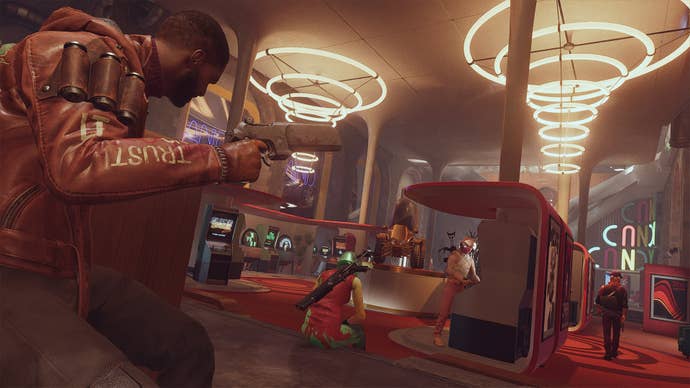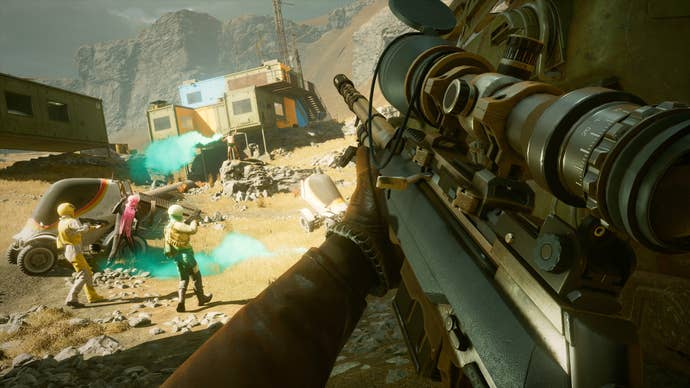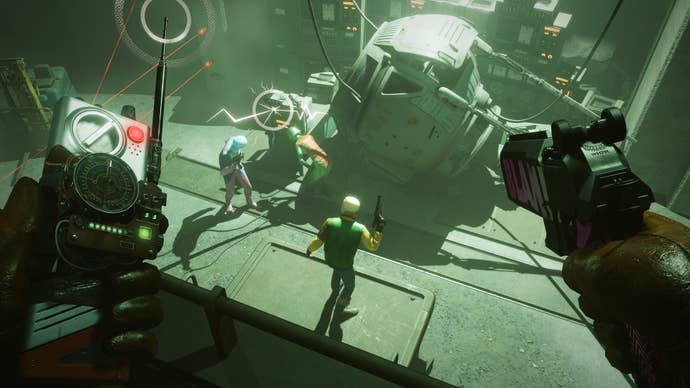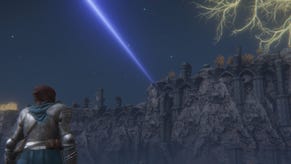Deathloop review: a thrilling, slick adventure - and Arkane's best game yet
By refining the studio’s strong suits and introducing a killer new gimmick, Deathloop is Arkane’s finest game yet, and one of the best games of the year.
At the heart of Deathloop in both narrative and video game terms is the titular loop. One might argue that Arkane Studios has embraced something of a loop itself, too. There’s a certain type of game they make, a certain feel that ties together Dishonored, Prey, and now Deathloop. Like this game’s lead, Arkane has forged a new path with a canny combination of repetition and experimentation; repeating and refining many of the mechanics and ideas that made their past games great, while introducing new concepts that serve to elevate the game as a whole.
Like I said, chief among those mechanics is the loop. The island of Blackreef has been trapped inside a repeating daily cycle - and so regardless of if you die or survive the course of the day, you’ll wake up back in the same spot on the same morning. In the single-player narrative, protagonist Colt Vahn’s mission is to break the loop - which can only be done by committing a specific set of murders. Your targets are often well-fortified and protected, and thus reaching them will require a bunch of knowledge that, at the game’s onset, Colt doesn’t have.
Deathloop is built around this basic conceit. You’ll have leads on intelligence, new weapons, and ways to assassinate your targets - and though it’s impossible to tackle every lead at once, Colt and his rival assassin, Juliana, keep their knowledge between loops, while everyone else forgets. In some ways the way you approach this is linear - you get a bunch of information throughout a day that’ll allow you to do something specific in the next loop. In other ways it’s more open-ended, where you’re basically unlocking shortcuts - a passcode to a door learned in one loop will be remembered and can be used next time, and so on.
Given the proximity of the two releases, it’s difficult for me to talk about the time loop-driven information gathering of Deathloop without also thinking about the recently released Twelve Minutes - a game that uses the same trick. Twelve Minutes has come in for a lot of criticism for a lot of very valid reasons, but the way it doled out information and encouraged the player to use their knowledge from past loops to advance was one of the best things about the game. Deathloop has that - but just does it all better.
Time on Blackreef is split into a few different slices - Morning, Noon, Afternoon, and Evening. Rather than an in-game clock slowly advancing, each of the island’s zones has a unique world state at each time of day, meaning you get four ‘attempts’ at one of the island’s zones each in-game day. Depending on what time it is, people will be doing different things, areas will be locked or unlocked, and certain major events will be either in preparation or ongoing. Because you have to complete a specific set of objectives in order to break the loop, there’s also a scheduling puzzle element, too - to succeed, you need to figure out a schedule that’ll let you do everything you need to do in one day.

On top of this, you have to juggle your equipment and abilities between loops. While Colt keeps his knowledge from one loop to the next, the only way you can keep gear and abilities is through ‘Infusion’, a process that binds items to you and ensures you respawn with them when time loops due to death or the end of the day. Infusion costs a resource you collect while exploring and fighting - and there’s never quite enough, forcing difficult calls.
It’s challenging to explain how potent all of this is, and how cleverly it slots together with the school of design Arkane is so proficient at wielding. Gone is the skill tree, replaced with the more organic action of picking things up and facing agonizing decisions of what to infuse and keep for future loops. One type of skill, Slabs, are what I’d call the prototypical Arkane abilities. There’s one that’s basically just like Dishonored’s ‘Blink’ ability, for instance.These only drop from the boss characters, and are expensive as hell to infuse and keep. Multiple times I found myself pained as I decided between different Slabs, as each is uniquely useful.
Then there’s how the concept of the loop interacts with the story. Those classic immersive sim touches - audio files, notes, computer terminal chat logs - they’re no longer just world building, but often vital pieces of information that can be used in the next loop. Even idle overheard chatter between the grunt enemies peppered across the island can hold important clues - and it’s a genius way to ensnare the interest of even those players who wouldn’t naturally fully engage with Deathloop’s excellently written narrative.
Arkane is known for being pretty damn good at story stuff, and Deathloop is no exception. I think what’s most impressive about it is that there’s a well-developed cast of characters here - not just Colt and Juliana, the duelling assassins featured prominently in marketing, but also the other core characters that make up the architects and targets of Blackreef. These are the sorts of characters that are probably going to launch an avalanche of fan cosplay, art, and fiction. In-game, you mostly get to know them by hearing them on intercoms and skulking through their lairs, reading instant messaging logs and scribbled notes. To a degree, some of this feels a little like the best of BioShock - but focused on a fun, pulpy, tongue-in-cheek universe more than any navel-gazing philosophy.

You’re prodded to play as Colt first, to see and experience the story of Deathloop. You can do this on or offline, and regardless of which, your game can occasionally be ‘invaded’ by an AI or human-controlled Juliana that’ll work to hunt you down. As Colt, you’re faced with a choice when Juliana appears. If you don’t want to engage her, a character with equal abilities to yours, you can flee the zone, advancing time and missing whatever you were in that area at that time of day to do. If you stand and fight, it’ll be one of the hardest encounters but will give up awesome rewards.
The invasion stuff is a cool little wrinkle when playing the story, but the real fun comes when you’re on the other side. After familiarizing yourself with Blackreef you can take on the role of Juliana and invade other people’s games. Some of Deathloop’s earlier marketing might’ve given the impression that this competitive online element was the core of the game, that it’s a title with a multiplayer focus. It isn’t; it’s a single-player adventure first. But the ability to play as Juliana and invade others is a super satisfying way to see this world from another perspective, giving you a reason to keep playing. Ruining another person’s day is pretty fun, too.
The reason you’d want to keep playing is pretty damn simple, too: Deathloop feels bloody fabulous. It’s a tight-yet-slick game, with the options at your disposal at any given time all feeling equally viable - and crucially, equally fun. There’s none of that mismatch often in games like this where going guns blazing doesn’t feel quite right due to how the weapons handle, or where stealth is clunky and frustrating. Everything feels smooth and satisfying, from hacking doors and turrets to all-out gunfights, rapid parkour traversal to crouch-walking your way through a building while racking up stealth takedowns. When things go wrong, it’s easy to quickly switch approaches and pull out a big, loud gun.

The game does seem to want you to play stealthy, though - psychedelic notes from Colt’s alternate dimension selves often caution you “maybe don’t go loud” before entering enemy strongholds and the like - but guns blazing is totally an option if that’s what you desire. The weapons, upgrades (known here as trinkets) and slabs you choose to infuse to keep across loops will help to create a character build that’ll let you lean into a specific play-style.
I do have the odd criticism, of course. For example, with how important to the narrative and Colt’s knowledge various scattered items are, it’s frustrating that a readable crumpled-up note can have the same item model as one that’s unreadable, unrelated background clutter. I sometimes think the enemy AI is a little too quick to spot you from stealth - though certain slabs can remedy that. One of the guns included in the Digital Deluxe Edition is very good early on and felt a bit like cheating. I reviewed it on PS5, and I found the fine adjustments of aiming on a controller when trying to long-range headshot people in stealth to be fiddly thanks to low sensitivity - I can’t wait to start playing it on PC. These are all small critiques, of course. Certainly nothing game-breaking or earth-shattering.
Taken as a single-player experience, Deathloop feels complete and incredibly well-rounded. The extra injection of optional multiplayer action is a fabulous cherry on top. Basically, Deathloop is everything I wanted it to be. It’s confident both as a successor to many of the ideas of Dishonored while also expressly its own thing, with a tone and sense of style I absolutely adore. It’s one of my favourite games of the year - and one we’ll surely be talking about for months to come.
Disclaimer: Tested on PS5, with a copy of the game provided by the publisher. Additional reporting by James Bilcliffe.



.jpg?width=291&height=164&fit=crop&quality=80&format=jpg&auto=webp)



.jpg?width=291&height=164&fit=crop&quality=80&format=jpg&auto=webp)
